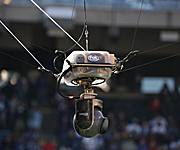- MENU
- HOME
- SEARCH
- WORLD
- MAIN
- AFRICA
- ASIA
- BALKANS
- EUROPE
- LATIN AMERICA
- MIDDLE EAST
- United Kingdom
- United States
- Argentina
- Australia
- Austria
- Benelux
- Brazil
- Canada
- China
- France
- Germany
- Greece
- Hungary
- India
- Indonesia
- Ireland
- Israel
- Italy
- Japan
- Korea
- Mexico
- New Zealand
- Pakistan
- Philippines
- Poland
- Russia
- South Africa
- Spain
- Taiwan
- Turkey
- USA
- BUSINESS
- WEALTH
- STOCKS
- TECH
- HEALTH
- LIFESTYLE
- ENTERTAINMENT
- SPORTS
- RSS
- iHaveNet.com
By Matt Coppa

Watching America's pastime has come a long way since sped-up and grainy black-and-white newsreel footage made Babe Ruth look like a big, fat mechanical rabbit on mescaline on the base paths.
In the last decade, we've seen the advent of high-definition broadcasts, base-cams, comet tails that track pitched and hit balls, and graphic K-zones that indicate whether a pitch's trajectory is in the strike zone.
So it's no wonder there are more folks planted in front of flat-screens than there are in front of the urinals at the ballparks.
So what's new this season?
There are two new tech treats stepping up to the plate that give viewers a better appreciation for the speed of the game -- and those umps who have been the victims of your vitriolic bile since you gained a gentleman's appreciation for the Grand Old Game.
Field Cams
FOX unveiled its overhead camera cable system, called the Field Cam, at the end of last season, but you can expect to see a lot more of it on this season's Saturday broadcasts, as well as at the all-star game and postseason playoffs.
The field cam is a computer-navigated camera suspended 12 to 80 feet above the action. It moves on a series of wires and pulleys across the whole diamond. The idea is to provide totally new angles on the action by following the players step-by-step from an aerial perspective.
While baseball purists fear the cameras could get in the way of the game, new precautions have been put in place to ensure that there will be no obstructions. In fact, the rigging will be confined to foul territory until after a pitch crosses the plate, so it won't interfere with play ... at least that's the plan.
"Last year, we were only allowed to have it maneuver out of play, so if the Dodgers' Rafael Furcal hit a single, we could only follow him from home to first base," says Dan Bell, vice president of communications for FOX Sports. "With this version, we can follow him from first base to third. We want to extend the field and give viewers shots that they've never seen before."
This bird's-eye view will certainly do that and provide new perspectives that will continue to pressure the game's officials to utilize replay angles when reviewing umpire calls during the game.
Umpire Cams
When the Marlins' Josh Johnson paints the outside black with a 97 mph fastball, or when Philadelphia's Roy Halladay bends a 6-inch curveball across the plate, it may seem obvious to you which is a ball and which a strike. (Here's a hint: It's the one that helps the home team!)
Still, everybody knows that it's the umpire who has the best view of a pitched ball, so this year, FOX will give viewers the same split-second look at exactly where the ball crosses the plate, using mini cameras mounted on home-plate umpires' masks.
"You get that feeling of just how quickly the pitch reaches the plate and what the reaction time of a hitter really is," explains FOX Sports Co-President Eric Shanks.
So here's your chance to see if you can make the correct call on a Major League pitch one second after it rockets into the catcher's mitt. If you can, you may want to give Bud Selig a call about a job.
"These advancements are all about taking viewers where they haven't gone," explains FOX announcer Joe Buck. "Baseball's always been something that you've looked at arm's length. If you can get in there a little more, learn more about the player's personalities, get inside what they do during the course of a game, you can speed things up and make it more interesting."
Luckily, we're still not inside enough to get a gob of tobacco spat in our face ... yet. Play ball!
Photo Credit: Getty Images
Available at Amazon.com:
The Psycho 100: Baseball's Most Outrageous Moments
Brand-new Looks at the Grand Old Game - Major League Baseball